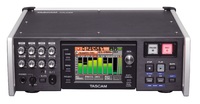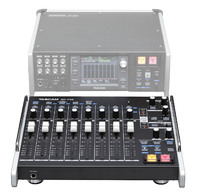Multi-track Recorders on Modern Sets
 On todays feature films and episodic television, the use of 8-12 channel multi-track recorders have become standard operating procedure. Popular units include the Tascam HS-P82, Sound Devices 788T, and the Zaxcom Deva Fusion 10/12.
On todays feature films and episodic television, the use of 8-12 channel multi-track recorders have become standard operating procedure. Popular units include the Tascam HS-P82, Sound Devices 788T, and the Zaxcom Deva Fusion 10/12.
 The basic approach is to independently record each of your microphones onto its own channel, while simultaneously live mixing your mics to a composite or mixed down track. The mixdown version is used for immediate playbacks, dailies, and for the picture edit. After the picture cut is “locked”, the sound editors have the option of re-constructing all or part of the live production mix from the raw independent tracks (iso’s)
The basic approach is to independently record each of your microphones onto its own channel, while simultaneously live mixing your mics to a composite or mixed down track. The mixdown version is used for immediate playbacks, dailies, and for the picture edit. After the picture cut is “locked”, the sound editors have the option of re-constructing all or part of the live production mix from the raw independent tracks (iso’s)
As we have pointed out, sound mixers utilize a variety of microphone techniques for acquiring a full and realistic soundtrack. A typical feature film or TV show may use one or two boom mics simultaneously, along with some plant mics deployed around the set to get what the booms cannot, and a handful of radio mics on the key actors to cover action or as (iso) backup.
In the field, the sound mixer has the option of feeding the recorder from any suitable external mixing console, or utilizing a dedicated fader controller provided by the recorder manufacturer.
 When the dedicated fader controller accessory is used, these recorders are able to record up to eight (or more) external inputs as iso’s, while simultaneously assigning and mixing down these channels to an additional pair of stereo tracks. The recording level for each input is initially set by use of the trim/gain pot, which determines the recording level onto each iso track. The levels of the mixdown stereo tracks are actively controlled by the faders (or pots), allowing the soundmixer to adjust mics during the take.
When the dedicated fader controller accessory is used, these recorders are able to record up to eight (or more) external inputs as iso’s, while simultaneously assigning and mixing down these channels to an additional pair of stereo tracks. The recording level for each input is initially set by use of the trim/gain pot, which determines the recording level onto each iso track. The levels of the mixdown stereo tracks are actively controlled by the faders (or pots), allowing the soundmixer to adjust mics during the take.
Example: Inputs/tracks 1-8 represent boom, plant, and radio mics. They are mixed down to tracks 8-9.
Sometimes, the use of a more sophisticated mixing console is preferred. External mixing boards (such as the Presonus 16.4.2) offer a greater number of microphone inputs, subs, monitor outs, boom outs, better signal processing (EQ, compression, gates, limiters, etc.) and digital recall. The downside of using a non-dedicated mixing panel is that the soundmixer sometimes (depending on the particular model of multi-track recorder) can no longer avail himself of being able to record all of the inputs as iso’s and mix them down to a stereo pair. (Some recorders are not friendly when it comes to fluidly accessing and controlling the levels to their internal mixdown tracks.)
Instead, the soundmixer will simply dedicate one of the recorder inputs to receive the mixdown from the panel; and utilize the remaining recorder inputs for iso’s.
Example: Recorder Input/track 1 is fed from the main output of the board. Recorder input/tracks 2-7 could be iso’s (boom, radio mics), and are sent from the Direct Outs of the mixer. Any misc plant mics or radio mics could be assigned to one or two of the mixer Sub or Aux Outputs, and that Aux Output(s) could be sent to input/track 8 (or tracks 7 & 8) of the recorder.
In this way, a complex show involving a large number of microphones could be mixed down to 8 or 10 tracks. Not every microphone needs to have its own iso track. An aggregate of minor characters could be combined to one Aux track; or any actors whose lines do not overlap in the timeline (i.e. do not appear in the scene at the same time) might easily share a single iso track.
Reality TV
Sometimes, a sound mixer is just a recordist. A growing trend amongst so-called reality television shows is to just record everything that moves, and then just let the editors deal with it.
On set, the soundperson is responsible for recording the iso tracks, consisting of a number of radio mics and maybe a boom mic for ambiance or misc audio. The mixdown is not important at this stage, since it is being shot documentary style, and most likely with multiple cameras. Until a story is carved out of this footage by the editors, a soundperson would have no way of knowing which mics to open and close or what perspective to mix for, so very little priority is given to achieving a live mixdown.
In most cases, it is a matter of set ‘em and forget ‘em. Get clean audio on all of your tracks, and don’t worry about the mix. To give credit where credit is due, wrangling all of those wireless and a boom – in an unscripted environment full of the unexpected – is a skill all of its own, and one that is far from easy.
Choose what works for you
In this article we have examined a few different approaches to the use of multi-track recording for film and video production.
You no longer have to decide between having a balanced, live mix production soundtrack for dailies and editing, complete with the occasional human error of a missed cue – or a set of virgin iso tracks, devoid of any fader activity, that can later be reconstructed into the perfect soundtrack.
The benefit of multi-track is that it allows you to “have your cake and eat it too”.
